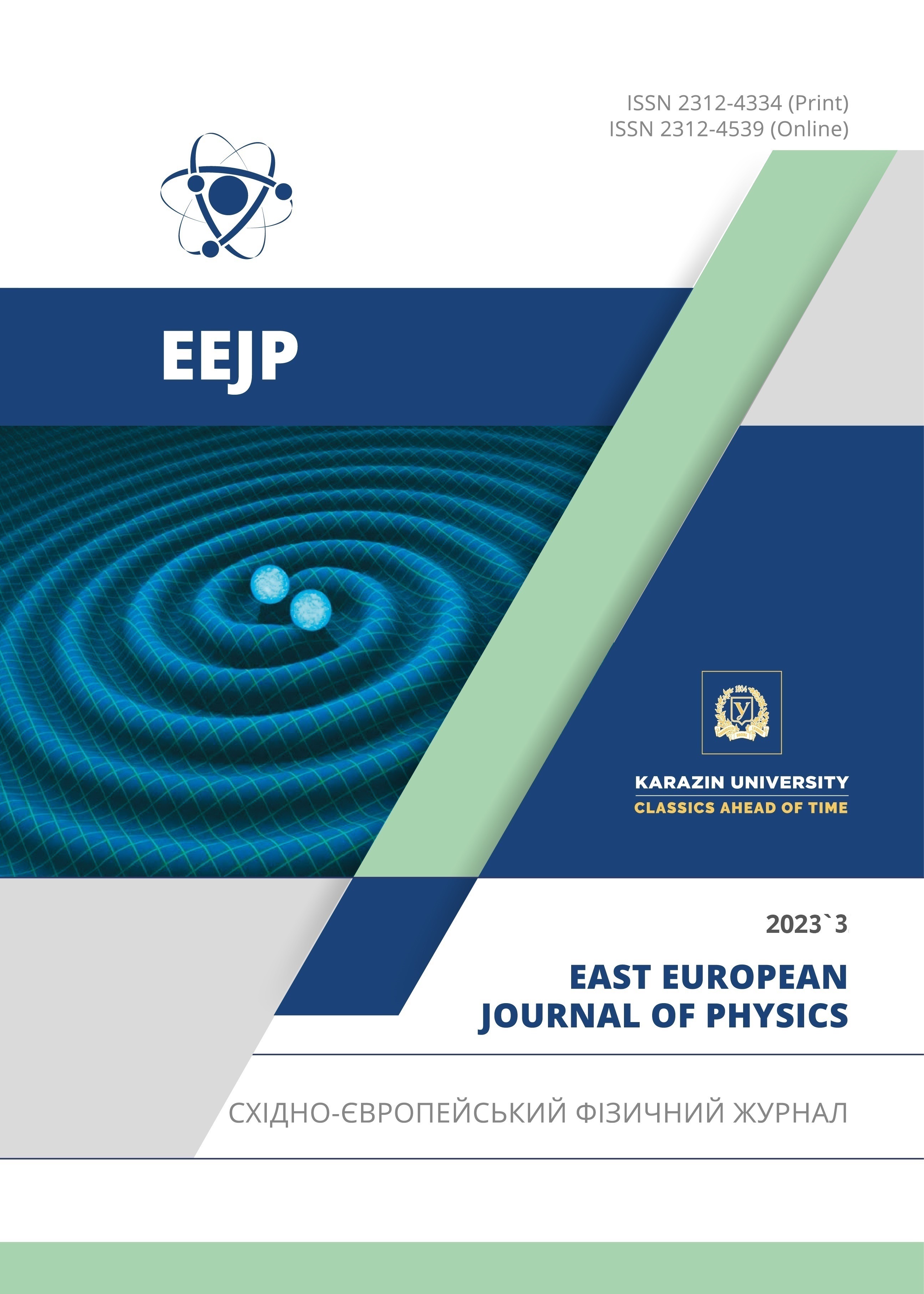Current Status of Silicon Studies with GexSi1-x Binary Compounds and Possibilities of Their Applications in Electronics
Abstract
The paper determines the technological regimes for obtaining GexSi1-x alloys by introducing germanium atoms into single-crystal silicon by the diffusion method. From the results of the study, it was found that the fundamental parameters of the formed GexSi1-x alloys differ from the fundamental parameters of the original silicon, in particular, the energy values of the silicon band gap change. Elemental analysis of the surface of the samples showed that the concentration of silicon (in atomic percent) was ~70.66%, germanium ~29.36%. It was assumed that on the silicon surface and in the front part, a thin layer of an alloy of a compound with a composition of approximately Ge0.3Si0.7 (0.5÷2 μm) would be formed. Analysis of the spectra (p shows that the spectrum contains peaks ~303 cm-1 and ~406 cm-1, corresponding to the Ge-Ge and Si-Ge bonds, respectively. It was also shown that GexSi1-x binary compounds are a new material for modern electronics, the possibility of creating properties on their basis in electronics was shown. It is proposed on their basis to create devices with new functionality and highly efficient solar cells.
Downloads
References
M. Tomassini, J. Veirman, R. Varache, et al., J. Appl. Phys. 119, 084508 (2016). https://doi.org/10.1063/1.4942212
A.S. Saidov, A.Sh. Razzakov, D.V. Saparov, Press Technical Physics Letters, 28(11), 927-928 (2002). https://doi.org/10.1134/1.1526886
J. Lindroos, D.P. Fenning, D.J. Backlund, E. Verlage, A. Gorgulla, S.K. Estreicher, H. Savin, and T. Buonassisi, J. Appl. Phys. 113(20), 204906 (2013). https://doi.org/10.1063/1.4807799
B. Cook, Energies, 15(8), 2957 (2022). https://doi.org/10.3390/en15082957
M. Ogino, Phys. Stat. Sol. (a), 72, 535 (1982). https://doi.org/10.1002/pssa.2210720214
T. Walthera, C. . Humphreys, A.G. Cullis, Appl. Phys. Lett. 71, 729 (1997). https://doi.org/10.1063/1.119627
F.A. Trumbore, Bell System Technical Journal, 309(1), 205 (1960). https://doi.org/10.1002/j.1538-7305.1960.tb03928.x
N.F. Zikrillaev, S.V. Koveshnikov, S.B. Isamov, B.A. Abdurahmonov, and G.A. Kushiev, Semiconductors, 56(1), 29-31 (2022). https://doi.org/10.1134/S1063782622020191
R. Duffy, V.C. Venezia, J. Loo, M.J.P. Hopstaken, M.A. Verheijen, J.G.M. van Berkum, G.C.J. Maas, Y. Tamminga, T. Dao, C. Demeurisse, Appl. Phys. Lett. 86, 081917 (2005). https://doi.org/10.1063/1.1869540
M.I. Alonso, K. Winer, Raman spectra of c-Si1-xGex alloys, Physical Review B, 39(14) 10056 (1989). https://doi.org/10.1103/PhysRevB.39.10056
A. Picco, E. Bonera, E. Grilli, and M. Guzzi, Physical Review, 82(11), 115317 (2010). https://doi.org/10.1103/PhysRevB.82.115317
D. Rouchon, M. Mermoux, F. Bertin, J.M. Hartmann, Journal of Crystal Growth, 392, 66 (2014). https://doi.org/10.1016/j.jcrysgro.2014.01.019
A.R. Toshev, В.A. Abdurakhmanov, Kh.M. Iliev, S.A. Tachilin, and В.Е. Egamberdiev, Surface Engineering and Applied Electrochemistry, USA, 46(5), 505 (2010). https://doi.org/10.3103/S1068375510050170
U. Schmid, N.E. Christensen, M. Cardona, Solid State Communications, 75(1), 39 (1990). https://doi.org/10.1016/0038-1098(90)90154-4
D. Duveau, B. Fraisse, F. Cunin, L. Monconduit, Chem. Mater. 27(9), 3226 (2015). https://doi.org/10.1021/cm504413g
H.-S. Tsai, Y.-Z. Chen, H. Medina, T.-Y. Su, T.-S. Chou, H.-S. Tsai, Y.-Z. Chen, et al., Physical Chemistry Chemical Physics, 17(33), 21389 (2015). https://doi.org/10.1039/C5CP02469B
E. Onaran, M.C. Onbasli, A. Yesilyurt, H.Y. Yu, A.M. Nayfeh, and A.K. Okyay, Optics Express, 20(7), 7608 (2012). https://doi.org/10.1364/OE.20.007608
J. Ghosh, S.K Chattopadhyay, A.K. Meikap, and S.K. Chatterjee Indian Academy of Sciences, 29(4), 385 (2006). https://doi.org/10.1007/BF02704140
D. Duveau, B. Fraisse, F. Cunin, and L. Monconduit, Chemistry of Materials, 27(9), 3226 (2015). https://doi.org/10.1021/cm504413g
A.S. Risbaev, J.B. Khujaniyazov, I.R. Bekpulatov, A.M. Rakhimov, J. Surf. Investig. 11, 994 (2017). https://doi.org/10.1134/S1027451017050135
N.F. Zikrillaev, G.A. Kushiev, S.B. Isamov, B.A. Abdurakhmanov, O.B. Tursunov, J. Nano- Electron. Phys. 15, 01021 (2023). https://doi.org/10.21272/jnep.15(1).01021
Copyright (c) 2023 Nurulla F. Zikrillaev, Giyosiddin A. Kushiev, Sergey V. Koveshnikov, Bakhromjon A. Abdurakhmanov, Ugiloy K. Qurbonova, Abdujalol A. Sattorov

This work is licensed under a Creative Commons Attribution 4.0 International License.
Authors who publish with this journal agree to the following terms:
- Authors retain copyright and grant the journal right of first publication with the work simultaneously licensed under a Creative Commons Attribution License that allows others to share the work with an acknowledgment of the work's authorship and initial publication in this journal.
- Authors are able to enter into separate, additional contractual arrangements for the non-exclusive distribution of the journal's published version of the work (e.g., post it to an institutional repository or publish it in a book), with an acknowledgment of its initial publication in this journal.
- Authors are permitted and encouraged to post their work online (e.g., in institutional repositories or on their website) prior to and during the submission process, as it can lead to productive exchanges, as well as earlier and greater citation of published work (See The Effect of Open Access).








